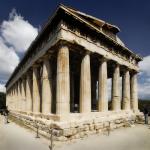|
This section contains 1,662 words (approx. 6 pages at 300 words per page) |

|
Beginnings.
Among the scraps of poetry that have survived by the seventh-century B.C.E. lyric poet Archilochus of Paros, one describes the poet's ability to start the dithyramb ("graceful round of song") of the lord Dionysus, when wine has loosened his mind. This is the first time that the word dithyramb appears in surviving Greek literature, though scholars are certain that Archilochus was not the first Greek to use it. The dithyramb was a song and dance in honor of Dionysus at festivals where much wine was drunk. The Greeks themselves did not know how the dithyramb developed. Several Greek states claimed it as their invention, yet it most likely developed among the Dorians who lived in the Peloponnesos south of the Isthmus of Corinth.
 Monument erected by Lysicrates in Athens to commemorate the victory of a chorus of boys in the dithyramb contest of...
Monument erected by Lysicrates in Athens to commemorate the victory of a chorus of boys in the dithyramb contest of...|
This section contains 1,662 words (approx. 6 pages at 300 words per page) |

|




